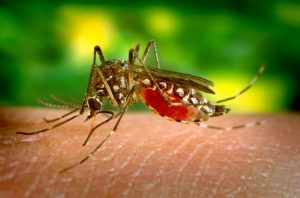12 December 2018
Researchers predict areas of mosquito-borne disease risk in Brazil
Posted by Sandra Ortellado
Scientists are looking at factors that influence human-mosquito interactions to assess risk of potentially fatal mosquito-borne diseases
By Sofie Bates

Aedes aegypti mosquitoes act as vectors, transmitting deadly diseases like Dengue Fever when infected mosquitoes bite humans.
Credit: James Gathany on Flickr
Tracking human demographic, climate, and environmental data may help scientists predict and prioritize areas with high risk for mosquito-borne diseases, according to new research.
In a new study presented in a poster session this week at the 2018 American Geophysical Union Fall Meeting in Washington, D.C., researchers built a numerical model that predicted areas in Brazil at risk for mosquito-borne disease outbreaks.
Unlike other models that make outbreak predictions based solely on climate factors, in the new study the researchers also considered how human demographics, such as the percentage of people living in poverty or how many households had a garbage collection service, affect the spread of mosquito-borne diseases such as dengue.
They hope that taking human demographics into account will improve risk predictions, helping policymakers make decisions to stop the spread of potentially deadly mosquito-borne diseases like dengue, which causes severe pain, and chikungunya, which also causes fevers.
“We want to give this information to policymakers so they can use it to make decisions, otherwise it’s just interesting math,” said Kaitlyn Martinez, a PhD student at the Colorado School of Mines who presented the work.
Infected mosquitoes spread viral and parasitic diseases when they bite humans. Both climate factors and human demographics determine how often people come into contact with mosquitoes that may be carrying deadly diseases.
In the new study, researchers gathered data from the Brazilian census to get information on human demographics in over 5,000 cities and towns. They then analyzed satellite imagery and weather station records of temperature and rainfall.

Martinez and colleagues in Brazil to collaborate with public health officials and promote women in STEM. Left to right: Lora Billings, Schweta Bansal, Kaitlyn Martinez, Sara Del Valle.
Credit: Kaitlyn Martinez
Researchers typically make predictions about infectious disease risk from climate or clinical data, but medical records can be messy and unreliable in developing countries. Instead, Martinez and her team turned to factors that were easy to observe to predict disease outbreaks in real-time.
In total, the massive dataset had over 2,000 variables, which the researchers simplified by monitoring 39 factors that were most representative of overall trends.
They expected some factors, such as higher temperature or the number of people per household, to be associated with increased disease risk. Warmer temperatures are more suitable for mosquito breeding; more people living close together increases the chances that those people will transmit diseases to each other.
However, some of the factors were surprising. For example, one of the biggest risk factors was the percentage of households without a garbage collection service.
Mosquitoes lay eggs in stagnant water. Martinez speculates that garbage may accumulate little pools of water when it rains, creating hotspots for mosquitoes – and the diseases they spread – outside of homes without a service to take away their trash.
Because the factors aren’t disease-specific, in theory scientists can use the model to predict the risk of similar vector-borne disease outbreaks: chikungunya, malaria, West Nile virus, or Zika. This means researchers can use the model to make predictions about diseases for which there isn’t much data, such as chikungunya.
To test the model’s accuracy, the researchers looked back at an outbreak of chikungunya from 2016 to see if their model could predict it in hindsight. Based on human demographics and climate data from that year, the model generated a map of disease risk. It was remarkably similar to what actually happened in the 2016 outbreak.
In areas where the model predicted high risk, there were more chikungunya cases during the outbreak in 2016. This told the team that human demographics and climate data could accurately predict mosquito-borne disease risk.
As with any model, there are limitations. However, Martinez is optimistic that scientists’ ability to predict mosquito-borne disease risk will improve as their models do.
“I hope one day we’ll be able to forecast disease like NOAA forecasts the weather,” she said.
-Sofie Bates is a master’s student in the science communication program at the University of California, Santa Cruz. See more of her work at sofiebates.com or follow her on Twitter @sciencesofie.


 GeoSpace is a blog on Earth and space science, managed by AGU’s Public Information staff. The blog features posts by AGU writers and guest contributors on all sorts of relevant science topics, but with a focus on new research and geo and space sciences-related stories that are currently in the news.
GeoSpace is a blog on Earth and space science, managed by AGU’s Public Information staff. The blog features posts by AGU writers and guest contributors on all sorts of relevant science topics, but with a focus on new research and geo and space sciences-related stories that are currently in the news.